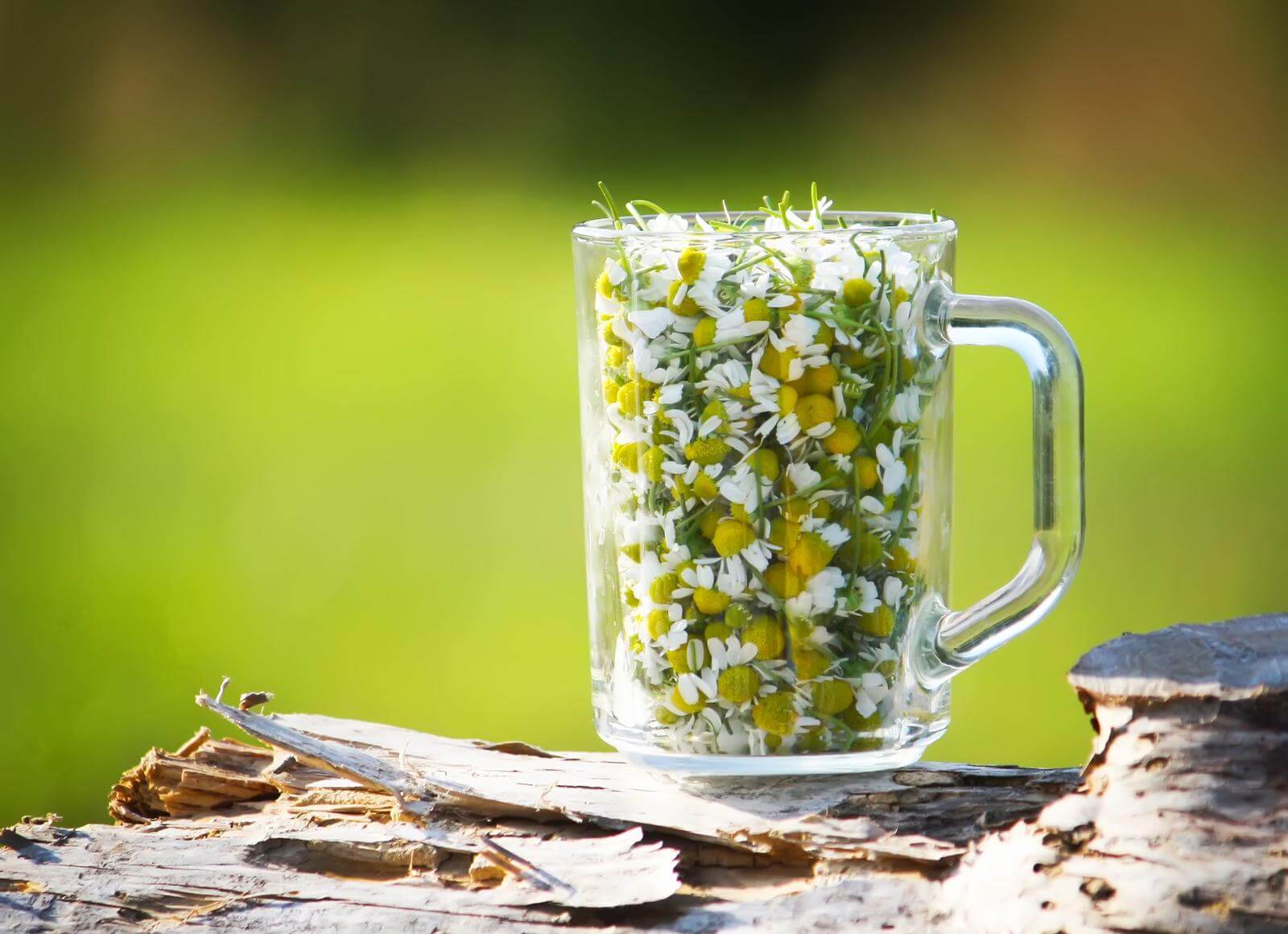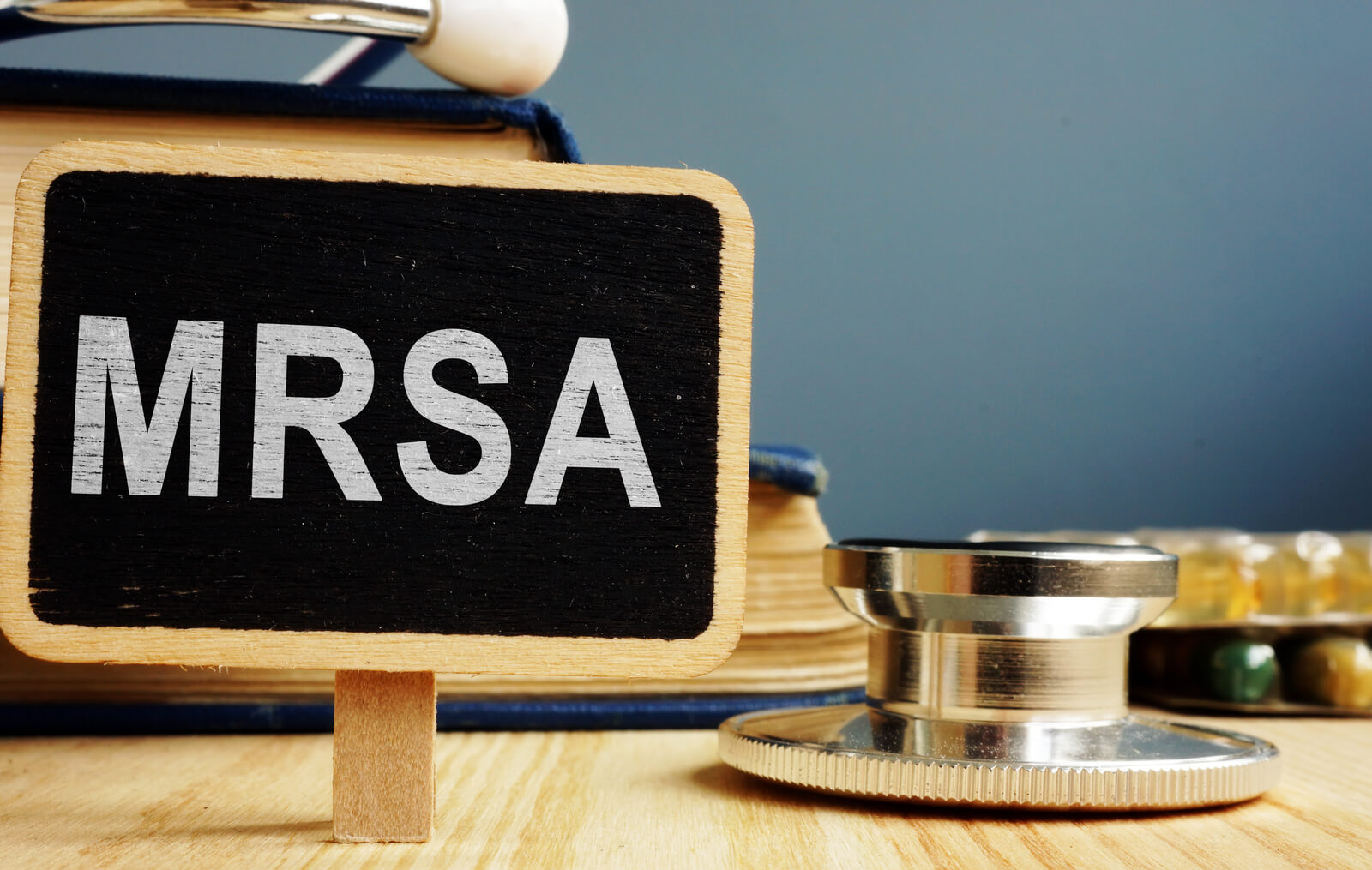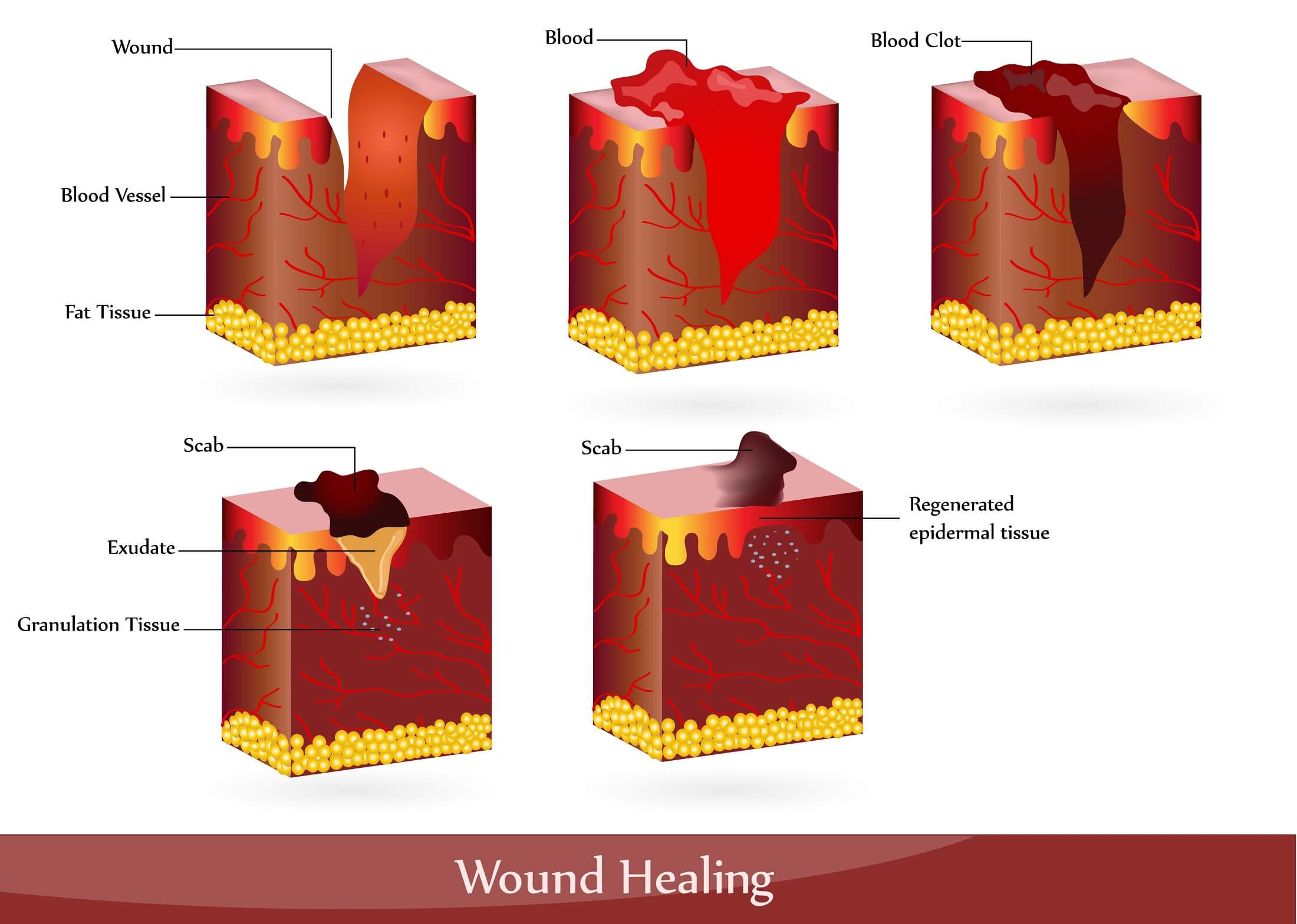
So, is chamomile (Matricaria chamomilla) an antibacterial herb? The answer is yes. Chamomile extract has broad-spectrum antibacterial ability. This power might be due to the extract’s ability to interfere with the cell wall permeability barrier and the inhibition of cell membrane enzymes.
Concerning drug resistant bacteria, one study we will discuss showed chamomile flower extract was able to stop the growth (inhibit) of 20 out of 24 strains of Methicillin-resistant Staphylococcus aureus (MRSA). Additionally, chamomile leaf extract was able to kill multidrug resistant Pseudomonas aeruginosa (P. aeruginosa) at a concentration of 25 mg/mL.
As the studies we will show state, it is safe to conclude that chamomile is an herb that can help stop many different kinds of bacteria. And, it can even help wounds to heal and get rid of the bacteria in those wounds. As a result, this herb is a great natural first-aid item to keep on hand to mitigate wound infections. Plus, it has many other benefits that are beyond the scope of this article!
Dosage Guidelines
The late, and renowned, Dr. James A. Duke (find out more about Dr. Duke on the U.S. government’s USDA website) discusses chamomile in his book The Green Pharmacy Herbal Handbook.(source 1) Dr. Duke states for medicinal purposes, you might want to go with German chamomile (Matricaria chamomilla). Also, research appears to focus more on German chamomile than Roman chamomile.
For dosage guidelines for chamomile, Dr. Duke suggests taking:
- Two or three 350 mg capsules three times a day.
- 2 to 3 teaspoons of dried chamomile flowers in a cup of hot water.
- 1/2 to 1 teaspoon of chamomile tincture up to three times a day
- 1/4 to 1 teaspoon of a liquid extract three times a day
- You can use a chamomile poultice by applying it directly to the area.
Dr. John Herzog (MD)
Dr. John Herzog, a "survival surgeon" from Maine explains what home remedies work best in a crisis situation.
This may be important in the event you require first-aid or are in an emergency situation without easy access to a hospital. Dr. John Herzog has assembled a large collection of home remedies for such scenarios.

The Antibacterial Ability of Matricaria chamomile

A 2015 study in the British Microbiology Research Journal(source 2) looked at how a chamomile extract would affect bacteria. The study made an ethanolic extract of chamomile powder with 10% ethanol. The species of chamomile being used was Matricaria chamomilla L.
The study tested the extract for antibacterial effect against five bacteria: Staphylococcus aureus (S. aureus), Escherichia coli (E. coli), Pseudomonas aeruginosa (P. aeruginosa), Enterococcus faecalis (E. faecalis), and Klebsiella pneumoniae (K. pneumoniae).
In addition to testing the extract in this regard, the antibacterial drug tetracycline. Tetracycline is grouped into a class of medications called tetracycline antibiotics. This drug works by inhibiting the growth and spread of bacteria. It is used for a variety of bacterial infections like pneumonia, intestinal infections, genital infections, and skin infections.(source 3)
The study found the minimum inhibitory concentration (MIC; this means the lowest concentration of a substance that stops, i.e. inhibits, the growth of a microorganism) of the chamomile extract.
The approximate MIC for Chamomile extract were as follows (tetracycline MIC included for reference):
- S. aureus: 15 mg/mL (tetracycline: 15 mg/mL)
- E. coli: 31 mg/mL (tetracycline: 31 mg/mL)
- P. aeruginosa: 64 mg/mL (tetracycline: 16 mg/mL)
- E. faecalis: 31 mg/mL (tetracycline: 16 mg/mL)
- K. pneumoniae: 16 mg/mL (tetracycline: 16 mg/mL)
The study also found the minimum bactericidal concentration (MBC; this means the lowest concentration that actually kills the bacteria, not just arrest the growth) for the chamomile extract against the bacteria.
The approximate MBC for Chamomile extract were as follows (tetracycline MBC included for reference):
- S. aureus: 17 mg/mL (tetracycline: 17 mg/mL)
- E. coli: 31 mg/mL (tetracycline: 31 mg/mL)
- P. aeruginosa: 63 mg/mL (tetracycline: 17 mg/mL)
- E. faecalis: 31 mg/mL (tetracycline: 17 mg/mL)
- K. pneumoniae: 16 mg/mL (tetracycline: 16 mg/mL)
The study stated that chamomile extract has broad-spectrum antibacterial ability. This power might be due to the extract’s ability to interfere with the cell wall permeability barrier and the inhibition of cell membrane enzymes. The sesquiterpenoid compounds of chamomile like bisabolol were stated to have the ability to interrupt the Gram-positive bacterial cell membrane.
For further explanation of the Gram-positive cell membrane:(source 5)
Gram-positive bacteria lack an outer membrane but are surrounded by layers of peptidoglycan many times thicker than is found in the Gram-negatives. Threading through these layers of peptidoglycan are long anionic polymers, called teichoic acids.
Cold Spring Harbor Perspectives in Biology [2.5 (2010): a000414-a000414]
A 2013 study in Industrial Crops and Products(source 4) determined the antimicrobial activities of chamomile (Matricaria chamomilla L.) essential oil and extract. The bacteria the essential oil and extract of this herb were tested on included: E. coli, Salmonella typhi (S. typhi), Bacillus cereus (B. cereus), and S. aureus.
Several different solvents were used to create extracts, one of which was ethanol. Plant material was round and macerated, 20 g of the material was added to 200 ml of solvents. This mixture was then shaken at room temperature for 72 hours. After further processing, the extract was finished.
A disc diffusion test was carried out on the various bacteria. This type of test involves placing a small amount of a test substance on a petri dish and inoculating that dish with a microorganism. The space around the test substance where nothing grows is known as the zone of inhibition (ZOI).
20 mcg (micrograms; 1 mg = 1000 mcg) of the chamomile ethanolic extract produced the following ZOIs:
- E. coli: 19 mm
- S. typhi: 17 mm
- B. cereus: 20 mm
- S. aureus: 23 mm
Claire Goodall’s Amazing Guide
Clair Goodall is a bee-obsessed, natural medicine convert from Minnesota (USA). And, she does keep bees!
Clair has created 350+ page book documenting how to replace the toxic products and medications in your home with healthier, all-natural alternatives.

Matricaria chamomile and Drug Resistant Bacteria

A 2021 study in the Infection Epidemiology and Microbiology(source 7) looked at how an ethanol based chamomile extract would affect drug resistant bacteria. To this end, the researchers tested extracts of Matricaria chamomilla leaves and flowers against drug resistant strains of S. aureus and P. aeruginosa. The type of drug resistant S. aureus used was Methicillin-resistant Staphylococcus aureus; commonly referred to as MRSA.
To create their extract the study dried the plant parts and then ground them. The ground material was placed into pure ethanol and allowed to sit for 72 hours. The fluid was then filtered, concentrated, and further processed into the dilutions used by the tests.
For the tests the study used 24 different strains of MRSA and 16 different strains of multidrug-resistant (MDR) P. aeruginosa. In the experiments regular non-drug resistant strains of S. aureus and P. aeruginosa were used as well.
The study’s findings for chamomile flower extract against MRSA showed it had antibacterial ability against 20 strains. The MIC of the extract against these strains was 6.25 mg/mL for 14 strains; and 12.5 mg/mL for 6 MRSA strains. The MBC was 12.5 mg/mL for 14 strains, and 25 mg/mL for 6 strains.
The study’s findings for chamomile leaf extract against MRSA showed the MIC to be 12.5 mg/mL for 7 strains. The MBC for this extract was 25 mg/mL for 7 MRSA strains.
Results of the chamomile flower extract showed it was not able to inhibit MDR P. aeruginosa at any concentration tested. Similarly, the flower extract was not able to inhibit regular (non-drug resistant) P. aeruginosa at any concentration either.
Results of the chamomile leaf extract against MDR P. aeruginosa demonstrated a MIC of 12.5 mg/mL. This extract had an MBC of 25 mg/mL on the strains.
Consequently, the leaf extract showed antibacterial activity against MDR P. aeruginosa while the flower extract was more effective against MRSA strains.
Matricaria chamomile for Helicobacter pylori
A 2015 study in the Current Issues in Pharmacy and Medical Sciences(source 6) looked at how chamomile would impact Helicobacter pylori (H. pylori). H. pylori is a common bacteria that is responsible for causing stomach ulcers. It is more prevalent in less developed areas of the world.
The study tested various herbal extracts against H. pylori; among which was chamomile. The herbal extracts used in the study were individually made from thyme, peppermint, echinacea, and chamomile flowers (Matricaria chamomilla L.).
The extracts were made with either absolute alcohol (99.8% ethanol), 96% ethanol, 30% ethanol / 70% water, or ethyl acetate.
The study found the MIC for the herbal extracts and they ranged from 15.6 to 250 mcg/mL (micrograms per milliliter; 1 mg = 1000 mcg).
The extract from chamomile flowers had an MIC of 31.3 to 62.5 mcg/mL. The absolute alcohol extract had an MIC of 62.5 mcg/mL. Concerning MBC, the absolute alcohol extract had an MBC for H. pylori of 125 mcg/mL. Echinacea had the lowest MBC for the absolute alcohol extract at 62.5 mcg/mL.
The study concluded by stating that their results indicated that thyme, peppermint, echinacea, and chamomile could all be useful herbal medicines for H. pylori. These herbs have potential to prevent infection by this bacteria or to help the immune system fight H. pylori.
The chart below was taken from this study and shows the results of the extract testing against H. pylori. Note that extract number 4 had 30% water with 70% ethanol.

Antibacterial & Wound Healing Roman Chamomile

A 2018 study in Infectious Disorders-Drug Targets(source 8) examined how Roman chamomile (Chamaemelum nobile) would affect wound healing and the presence of bacteria in wounds. This study found that Roman chamomile ointment was a significantly better antibacterial and wound healing agent than the prescription drug tetracycline.
The study states that wound infection is one of the most common infectious diseases in the world. These infections can be difficult to treat, and bacterial factors are the most important aspects in wound development. Consequently, this study was undertaken to investigate the antimicrobial and wound healing properties of Roman chamomile against P. aeruginosa in vivo (an experiment conducted on a living organism; not one done in a test environment such as a petri dish).
To make the Roman chamomile ointment used to treat wounds, an extract of this herb was used to synthesize a gel containing 5% of this extract. To create the initial extract, dried Roman chamomile flowers were ground into a powder. 10 g of this flower powder was mixed with 120 ml of 50% ethanol. The extract was further processed to produce the final extract used in the ointment.
The study divided rats into three groups of 15 rats. Group I received Roman chamomile ointment, group II received tetracycline ointment, and group three was the control—which received the base ointment without Roman chamomile extract.
The study found the infections in the groups were eradicated in the following timeframes:
- Group I: approximately 3.1 days
- Group II: approximately 3.8 days
- Group III: approximately 9.3 days
The time to healing for the three groups of rats in the study were as follows:
- Group I: approximately 5.3 days
- Group II: approximately 6.3 days
- Group III: approximately 12.1 days
Side Effects of Chamomile
Common types of German and Roman chamomile flowers have the U.S. FDA’s generally recognized as safe (GRAS) status. Yet, there are some complications that can arise from chamomile to be aware of.
Chamomile might be able to induce labor by affecting the uterine muscles. And, chamomile may cause drug interactions with certain medications—such as the blood thinner warfarin. So, chamomile’s side effects and contraindications are more than just related to allergic reactions!
Herbsey has an entire article on the side effects of chamomile that also lists dosage guidelines. If you want to know how much chamomile to take, and situations where it probably isn’t safe, check out this article: Side Effects & Dosage Guidelines for Chamomile.
About the Author
Geoff Kent is a natural medicine enthusiast who has been researching and writing about natural medicine since 2008. Geoff is primarily a web developer, but also researches and authors written and video content about natural health. Geoff has a bachelor’s degree in Management Information Systems from the University of Northern Iowa.
More on Geoff KentImportant Disclosures & Disclaimers
It is important to use the information you find on Herbsey.com in the right way. Also for legal reasons, these disclaimers and disclosures are necessary. For further information about each, feel free to click the link provided to the page on this website that provides more information.
Medical Disclaimer
The information on this website is not a prescription for anyone. This information is for informational or educational purposes only, and is not a substitute for professional medical advice or consultations with healthcare professionals.
Advertisement Disclosure
Some of the links provided on this article and website are affiliate links. If you purchase a product after clicking on these links, Herbsey.com will earn a commission. Herbsey.com promotes various products through advertisement and text links. For more information: Our Advertisements.






